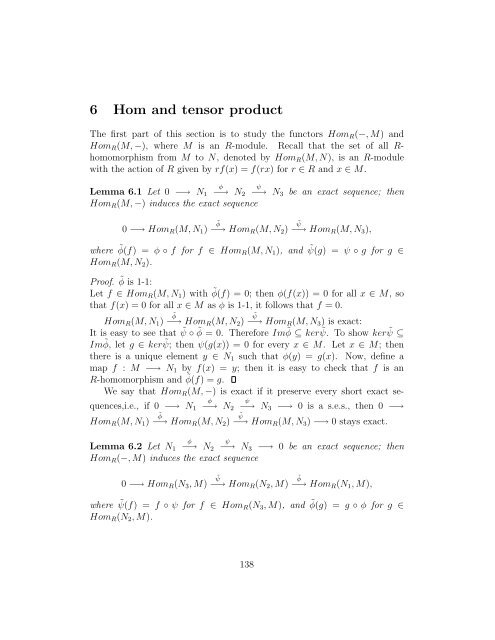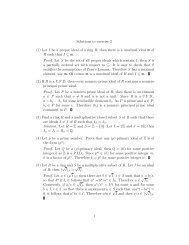Topics in algebra Chapter IV: Commutative rings and modules I - 1
Topics in algebra Chapter IV: Commutative rings and modules I - 1
Topics in algebra Chapter IV: Commutative rings and modules I - 1
You also want an ePaper? Increase the reach of your titles
YUMPU automatically turns print PDFs into web optimized ePapers that Google loves.
6 Hom <strong>and</strong> tensor product<br />
The first part of this section is to study the functors HomR(−, M) <strong>and</strong><br />
HomR(M, −), where M is an R-module. Recall that the set of all Rhomomorphism<br />
from M to N, denoted by HomR(M, N), is an R-module<br />
with the action of R given by rf(x) = f(rx) for r ∈ R <strong>and</strong> x ∈ M.<br />
Lemma 6.1 Let 0 −→ N1<br />
φ<br />
−→ N2<br />
ψ<br />
−→ N3 be an exact sequence; then<br />
HomR(M, −) <strong>in</strong>duces the exact sequence<br />
0 −→ HomR(M, N1)<br />
˜φ<br />
˜ψ<br />
−→ HomR(M, N2) −→ HomR(M, N3),<br />
where ˜ φ(f) = φ ◦ f for f ∈ HomR(M, N1), <strong>and</strong> ˜ ψ(g) = ψ ◦ g for g ∈<br />
HomR(M, N2).<br />
Proof. ˜ φ is 1-1:<br />
Let f ∈ HomR(M, N1) with ˜ φ(f) = 0; then φ(f(x)) = 0 for all x ∈ M, so<br />
that f(x) = 0 for all x ∈ M as φ is 1-1, it follows that f = 0.<br />
˜φ<br />
˜ψ<br />
HomR(M, N1) −→ HomR(M, N2) −→ HomR(M, N3) is exact:<br />
It is easy to see that ˜ ψ ◦ ˜ φ = 0. Therefore Im ˜ φ ⊆ ker ˜ ψ. To show ker ˜ ψ ⊆<br />
Im ˜ φ, let g ∈ ker ˜ ψ; then ψ(g(x)) = 0 for every x ∈ M. Let x ∈ M; then<br />
there is a unique element y ∈ N1 such that φ(y) = g(x). Now, def<strong>in</strong>e a<br />
map f : M −→ N1 by f(x) = y; then it is easy to check that f is an<br />
R-homomorphism <strong>and</strong> ˜ φ(f) = g.<br />
We say that HomR(M, −) is exact if it preserve every short exact se-<br />
quences,i.e., if 0 −→ N1<br />
HomR(M, N1)<br />
φ<br />
−→ N2<br />
˜φ<br />
−→ HomR(M, N2)<br />
ψ<br />
−→ N3 −→ 0 is a s.e.s., then 0 −→<br />
˜ψ<br />
−→ HomR(M, N3) −→ 0 stays exact.<br />
Lemma 6.2 Let N1<br />
φ<br />
−→ N2<br />
ψ<br />
−→ N3 −→ 0 be an exact sequence; then<br />
HomR(−, M) <strong>in</strong>duces the exact sequence<br />
0 −→ HomR(N3, M)<br />
˜ψ<br />
˜φ<br />
−→ HomR(N2, M) −→ HomR(N1, M),<br />
where ˜ ψ(f) = f ◦ ψ for f ∈ HomR(N3, M), <strong>and</strong> ˜ φ(g) = g ◦ φ for g ∈<br />
HomR(N2, M).<br />
138



